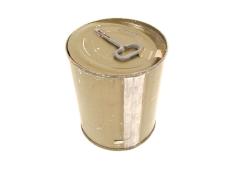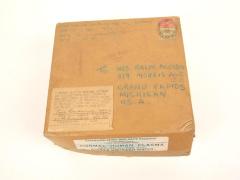Comments and Tags
Be the first to comment on this item!
Food and Drink
Military and Veterans ➔ Emergency Rations Kit, U.S. Military Issue
Identifier:
1995.54.11Description:
This amber, transparent plastic rectangular case with lid appears to be a World War II airplane survival kit. The case is still closed with the original tape. According to the directions on the flask it contains the following food and pharmaceutical items: chocolate, bouillon powder, malted milk and dextrose tablets, benzedrine sulfate (for preventing sleep), aspirin, halazon (for purification of water), antiseptic ointment, adhesive tape, matches, flask, and gum. The directions conclude with "NOTE: When no longer needed destroy or hide flask and all wrappers."It is one of the objects donated by Ralph Hauenstein, a Grand Rapids resident, former city editor of the Grand Rapids Herald, decorated World War II hero, successful entrepreneur and prominent West Michigan philanthropist. It was issued to Ralph Hauenstein in the European Theater of Operations during World War II.While other medical and ration kits from WWII are in the museum archives, none are the same as this kit.
Date:
circa 1942Materials:
Plastic, Paper, Foil, Food, ChemicalsDimensions:
5.75" h 4.25" w 1.5" dCurrent Location Status:
In StorageCollection Tier:
Tier 2Source:
Gift Of Ralph HauensteinExhibit/Program:
Ralph W. Hauenstein: A Life of Leadership (July 2018 – January 2019)This exhibition explores the extraordinary life of Ralph W. Hauenstein (March 20, 1912 - January 10, 2016), a leader in our community remembered for his role as a journalist, his military, and intelligence service, his dedication to the Catholic faith, his entrepreneurship, and his philanthropy in Grand Rapids. Ralph W. Hauenstein left a lasting legacy in the United States and around the world. His remarkable life demonstrates just how much a great leader can accomplish and serves as an inspiration to the next generation of leaders.
Featured in this exhibit are objects donated by Ralph to GRPM and also loaned items from Brian Hauenstein and other institutions.
Related Entities:
United States Armed Forces (creator)The United States Armed Forces was founded in 1775 upon the creation of the United States Continental Army. It consists of the Army, Marine Corps, Navy, Air Force, and Coast Guard. It is one of the largest militaries in the world in terms of the number of personnel actively serving in the United States. In addition, the United States Armed Forces has significant capabilities in both defense and power projection due to its large budget. It possesses both advanced and powerful equipment creating a widespread deployment of force around the world. As a result, the United States Armed Forces has the capability to build upon such power developing almost 800 additional military bases outside the United States. Ralph Hauenstein (donor)
Born March 20, 1912, in Fort Wayne Indiana, Ralph Hauenstein was a resident of the Grand Rapids area since the age of 12. A lifelong friend of Gerald R. Ford, 38th President of the United States, Hauenstein had been a journalist, war hero, entrepreneur, and philanthropist.
Hauenstein joined the U.S. Military in 1935 and, following officer training, became commander of an all-African-American Civilian Conservation Corps camp near Cadillac Michigan. In December 1940, after working for the Grand Rapids Herald as a journalist and then city editor, he returned to active duty as an intelligence officer in Iceland. During the Second World War, Hauenstein rose to the rank of colonel.
As Chief of the Intelligence Branch for the U.S. Army’s European Theater of Operations, he played a key role in the Ultra Project, which worked to decode German signals intelligence. Hauenstein received numerous decorations for his service, including the U.S. Legion of Merit, the French Croix de Guerre (with palm), and the Order of the British Empire. In 1944-45, Hauenstein was among the first Americans into the recently liberated Paris, Germany and Nazi concentration camps, including Dachau. Reflecting on his experiences, the Hauenstein Center quotes him as stating, “In the twentieth century, I saw with my own eyes the worst that leaders are capable of. In the twenty-first century, I want to encourage the best leadership possible so that the world will be better for my children’s children.” Hauenstein continued as an intelligence officer after the war, serving as Deputy Chief of Intelligence for the War Department from 1946-1947. His experiences in the Intelligence Branch are captured in the 2005 book Intelligence was My Line: Inside Eisenhower’s Other Command, as told by Ralph Hauenstein to Donald Markle.
Returning to the United States, Hauenstein worked to link the United States and Europe through trade establishing the Tri-Continental Trading Company in New York City and as the owner of Werner Lehara of Grand Rapids, a food equipment manufacturer that brought Goldfish crackers, Andes mints and other foods to the American consumer.
Alongside his entrepreneurial endeavors, he continues to work in service to the public. He served as a consultant on Eisenhower’s President’s Advisory Commission, served as an auditor at the Second Vatican Council in Rome in the 1960s, and participated in team supervising the first free Russian elections in 1996. One of the most prominent philanthropists in West Michigan, he has served on the board that founded the Van Andel Institute, founded the Hauenstein Center for Presidential Studies at Grand Valley State University, and provided seed money for the Hauenstein Neurosciences Center at Saint Mary’s Health Center.

